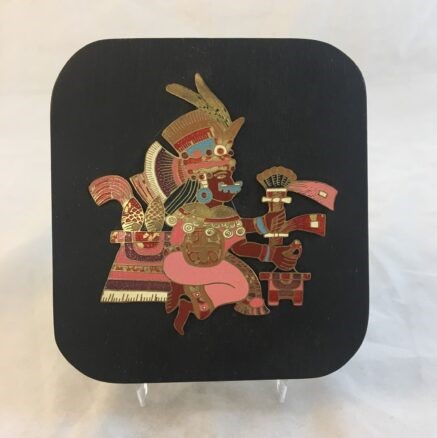The plaques in this display illustrate colorfully painted brass figures, each on a blackened wooden base. The images portrayed on these wooden plaques are reproductions of characters found in Mesoamerican codices, or screenfold books, that were used to record histories, the calendar system, and religious belief systems. The clear style and depiction of the figures indicates that these are images from Central Mexican (Aztec or Mixtec cultures) codices that were created just before Spanish contact with the Americas, as with the Codex Borgia, or relatively soon after Spanish contact, as in the case of the Codex Borbonicus and the Codex Magliabechiano. As noted on the back of each plaque, the images reproduced on these plaques each represents a deity in the Postclassic Mesoamerican pantheon, and each deity has been identified as roughly corresponding to a month in the European solar year.

Original: Aztec/Mixtec cultures, Postclassic period (900-1521 CE)
Reproduction: Mexican Mestizo cultures, 20th century
Painted metal, L. 7.5 cm x W. 1 mm x H. 9.8 cm
BFPC collection #2012.41c
The Central Mexican god known as Xipe Totec was the god of renewal and springtime. Xipe Totec means “our lord, the flayed one,” which refers to the practice of Aztec soldiers sacrificing captured enemy soldiers during the month of Xipe Totec, removing the skin of the sacrifices, and wearing the skin for days in rituals to re-enact battles with their comrades. When the skin would rot off their bodies, the soldier’s own skin would appear to be fresh and renewed in comparison to the dead skin, just as the earth puts on new foliage in the springtime. The wrinkles on the arms of this figure and the dangling extra pair of hands illustrate that the character in this image wears a flayed skin.

Original: Aztec Mestizo cultures, Post-Contact period (ca. 1550 CE)
Reproduction: Mexican Mestizo cultures, 20th century
Painted metal, L. 7.3 cm x W. 1 mm x H. 10 cm
BFPC collection #2012.41f
Tlaloc is the Central Mexican deity of rain and lightning who is known as “he who makes things grow.” Rain and other agriculture gods have particularly long histories and likely are among the oldest gods to have been worshipped in Mesoamerica. This depiction has a human body, but it wears a typical Tlaloc mask with goggle-like, round eyes, a twisted nose or mustache that resembles a cruller donut, and a fringe for a mouth; the blue color was likely used to symbolize water. One of the few deities to demand child sacrifices, Tlaloc was also greatly feared and was seen as necessary to appease, for rain can be nurturing, but it can also come in the form of damaging storms and floods.

Original: Aztec Mestizo cultures, Post-Contact period (ca. 1550 CE)
Reproduction: Mexican Mestizo cultures, 20th century
Painted metal, L. 79.8 cm x W. 1 mm x H. 7.2 cm
BFPC collection #2012.41h
Xilonen is the goddess of young corn, and her name translates as “tender ear of corn.” She is also sometimes referred to as Chicomecoatl, another goddess of agriculture. Unlike most of the other deities depicted in this set of plaques, Xilonen is not originally an Aztec goddess, but a goddess adopted into the Aztec pantheon from one of the cultures that the Aztec conquered and subsumed into their empire. During the festival of Xilonen a slave girl was sacrificed by decapitation to symbolize the process of harvesting corn, which required cutting the ear or “head” of corn from the stalk. As shown in this depiction, Xilonen’s identifying characteristics include a short, layered feathered headdress with long central feathers like a corn silk tassel, and ears of corn, as depicted on the altar behind this figure.

Original: Aztec Mestizo culture
Original: 16th century
Reproduction: Mexican Mestizo culture
Reproduction: 20th century
Painted metal, L. 6.2 cm x W. 1 mm x H. 9.2 cm
BFPC collection #2012.41i
Huitzilopochtli is the Central Mexican god of the sun and of war. His name translates as “the blue hummingbird of the left,” which refers to the courageous nature of the tiny hummingbird, along with the blue feathered headdress that this deity wears. Huitzilopochtli is a god that is unique to the Aztec, which developed as a military culture focused on war and conquering; along with Tlaloc, Huitzilopochtli is one of their patron deities. In the myth of the founding of their capital city of Tenochtitlán, the Aztec were finally able to settle down when they saw a sign consisting of an eagle standing on a cactus, devouring a snake in its talons; one version of this myth states that Huitzilopochtli took the form of the eagle to show them this sign on an island in Lake Texcoco.

Original: Aztec Mestizo culture
Original: Pre-Contact
Reproduction: Mexican Mestizo culture
Reproduction: 20th century
Painted metal, L. 7.9 cm x W. 1 m x H. 9.8 cm
BFPC collection #2012.41j
Xiuhtecuhtli is a god of fire, and he is one version of the old god of fire known as Huehueteotl by the Aztec. This god’s name is translated in several different ways, including “turquoise lord,” “the lord of grass,” and “the lord of the year.” A number of different ceremonies were celebrated in honor of Xiuhtecuhtli, including the sacrifice of male prisoners by burning; however, the Aztec did not generally torture their victims with painful deaths, and they are known to have drugged the sacrifices so that they would not suffer. One other important ceremony celebrated for Xiuhtecuhtli was performed only every eight years, when the planet Venus was in conjunction with earth’s solar calendar.
For more information, you may contact the researcher(s) noted in the title of this exhibit entry, or Dr. Billie Follensbee, the professor of the course, at BillieFollensbee@MissouriState.edu

